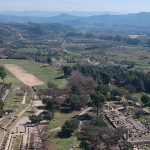Global History is a popular and expanding field, which seeks both to understand better the connectivity between human cultures, and to understand better individual human cultures through comparison with others. The connective and comparative global study of ancient cultures has, however, traditionally been focused on the dynamics of empires (e.g. the Roman and Chinese Han empires); the economics of connective trade routes (most famously the Silk Roads); and the comparative study of particular disciplines within different cultures (e.g. philosophy and science in ancient Greece and China).
I was the first ancient historian to join the Warwick University’s Global History and Culture Centre in 2017, marking an expansion of the remit of Warwick’s Global History agenda and a new connection between the Department of Classics and Ancient History and the Department of History. During my Leverhulme Research Fellowship in 2017-2018, I combined one of the hallmarks of the Warwick approach to global study – the analysis of the socio-cultural and political impacts of global trade – with the ancient historical evidence for developing trade networks. My research project examined the socio-cultural and political meaning and impact of the trade in luxury goods across the Mediterranean, Asia, India and China in the period 100 BC – 300 CE (when the permanent connective arteries of trade were being formulated across these communities). I asked three crucial questions about the impacts of particular luxury goods moving across these worlds:
1. How did these goods, as they moved along trading networks & through different recipient communities with different socio-cultural & political climates, change in their value and meaning?
2. In what ways did these goods themselves affect the socio-cultural & political values of their recipient communities?
3. To what degree did these goods alter the recipient communities’ understanding of the community of origin & the relative relationships between them?
The case-study luxury goods chosen offer different distinct points of origin, different directions of trade and encapsulate different opportunities for the attribution of value and meaning: first silk (originating from China and traded west as both raw material and finished garment); second black pepper (originating from Kerala, India and traded both east and west as finished product with long shelf life); and third blown glass (originating from the Roman Levant and traded east, as both luxury good in itself and container of other luxury goods [e.g. perfumed oils]).
During the course of the Fellowship, I gave research papers at the Global history centres at Warwick and Stanford, as well as at Fudan University, Shanghai, China, and as a visiting fellow at the Institute for the History of Ancient Civilisations, Northeast Normal University (‘NNU’), Changchun, China.






